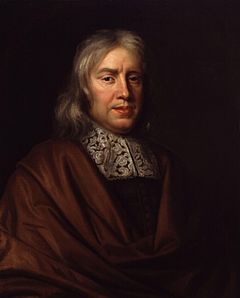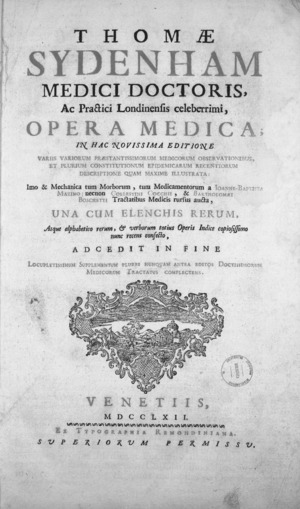Thomas Sydenham facts for kids
Quick facts for kids
Thomas Sydenham
|
|
|---|---|

Thomas Sydenham in a 1689 portrait by Mary Beale.
|
|
| Born | 10 September 1624 |
| Died | 29 December 1689 (aged 65) |
| Nationality | English |
| Alma mater | All Souls College, Oxford (MB, 1648) Pembroke College, Cambridge (MD, 1676) |
| Known for | Clinical medicine |
| Scientific career | |
| Fields | Medicine |
| Influenced | John Locke |
Thomas Sydenham (born September 10, 1624 – died December 29, 1689) was an English physician. He wrote a famous book called Observationes Medicae. This book was used as a main medical textbook for 200 years! Because of his important work, people called him 'The English Hippocrates'. Hippocrates was a very famous doctor from ancient Greece.
Sydenham made many discoveries. One of them was a disease now known as Sydenham's chorea. It is also called St Vitus' Dance. He is also remembered for saying, "A man is as old as his arteries." This means your health depends on your blood vessels.
Contents
Early Life and Education
Thomas Sydenham was born in Wynford Eagle, a village in Dorset, England. His father was a wealthy landowner. Thomas had a brother named Colonel William Sydenham.
When he was 18, Sydenham started studying at Magdalen Hall, Oxford. His studies were paused for a while because he joined the Parliamentarian army. This was during the English Civil War. He served as an officer.
In 1648, he finished his studies at Oxford. He earned a degree as a bachelor of medicine. Around the same time, he became a fellow at All Souls College. Many years later, in 1676, he earned his MD degree. He got this from Pembroke Hall, Cambridge. His oldest son was studying there at the time.
After 1648, he spent more time studying medicine in Oxford. But he soon returned to military service. In 1654, he received money from Oliver Cromwell. This was because his two brothers had died serving Parliament. Sydenham himself had also been injured while serving.
In 1655, he left his position at All Souls College. He married Mary Gee in his hometown of Wynford Eagle. They had two sons, William and Henry. Another son, James, died young.
In 1663, he passed the exams to practice medicine in Westminster and the surrounding areas. He had probably been living in London for some time before this. This basic license was his only connection to the College of Physicians.
Some doctors did not trust Sydenham. This was because he had new ideas and was very direct. He wrote that some people "suddenly turn if something is new, if someone should disclose something not previously said or heard." He also said that he was good at curing patients. But he added that he did not get along with some other doctors. He felt they criticized his new ideas but ignored fake doctors.
Sydenham had the support of important people like Robert Boyle and John Locke. His religious beliefs were an early form of natural theology. This means he believed in understanding God through nature.
His Work and New Ideas
Books He Wrote
Sydenham's first book was called Methodus curandi febres. This means The Method of Curing Fevers. It was published in 1666. A second edition came out in 1668, with a new chapter about the plague. The third edition, published in 1676, was larger. It had the more famous title, Observationes mediciae, which means Observations of Medicine.
In 1682, he published another book, Dissertatio epistolaris. This book was about treating smallpox and hysteria. In 1683, Tractatus de podagra et hydrope was published. This book was about managing Arthritis and Dropsy. His book Schedula monitoria de novae febris ingressu came out in 1686. This means The Schedule of Symptoms of the Newly Arrived Fever.
His last finished work was Processus integri, or The Process of Healing. This book was a summary of diseases and treatments. It was printed in 1692. This book has been republished many times in different countries. He also had some notes on pulmonary consumption (a lung disease) found after his death. All his writings were collected into about 600 pages in Latin.
The Father of English Medicine
Sydenham was a successful doctor during his lifetime. His books were reprinted and new editions were made. But he became truly famous as the "father of English medicine" or the "English Hippocrates" after he died.
People admired him for his way of treating smallpox. He used a "cooling" method, which meant letting the body heal naturally. He also supported using "Peruvian bark" for certain fevers. Today, we know this bark contains quinine, which treats malaria.
Some doctors at the time did not like his ideas. But others, like Richard Morton and Thomas Browne, understood his importance. A professor from the Netherlands, Herman Boerhaave, called him "the light of England" and "the true face of Hippocrates."
Sydenham is famous because he started a new way of practicing medicine. He also brought better ethics to the field. His new ideas became clear and influenced medicine many years later.
So, what were his new ideas? First, he always did his best for his patients. He did not make medicine seem mysterious or stick to old traditions. There are some great stories about him:
- Once, he saw a gentleman who was very sick and upset. Sydenham thought the man was weak from his illness and previous treatments. So, he told him to eat a roast chicken and drink some wine!
- Another time, a rich man thought he had hypochondria (imagined illnesses). Sydenham told him he could not help him. He said there was a great doctor in Inverness who could. The patient traveled all the way to Inverness. He found no doctor there. He came back to London angry, but he was cured!
- He famously advised Sir Richard Blackmore, who was studying medicine, to read Don Quixote. Sydenham said it was a "very good book." He also said there were times when he helped his patients most by "doing nothing at all."
In 1679, Sydenham gave Whooping cough the name pertussis. This means a very strong cough. He was a religious man. He believed that God only allowed humans to see the outside of things. So, he did not try to find hidden causes of diseases by looking inside the body.
Famous Sayings
- "A man is as old as his arteries."
- "I confidently affirm that the greater part of those who are supposed to have died of gout, have died of the medicine rather than the disease..." (He believed some gout treatments were worse than the disease!)
- "For humble individuals like myself, there is one poor comfort, which is this, viz. that gout, unlike any other disease, kills more rich men than poor, more wise men than simple." (He thought gout showed that nature is fair, affecting everyone.)
- "It becomes every man who purposes to give himself to the care of others, seriously to consider the four following things..." (He believed doctors should remember they serve God, help people, value human life, and be kind because they too will suffer one day.)
The famous saying Primum non nocere (First, do no harm) is often thought to be from Hippocrates. But it is actually linked to Sydenham in a book by an English surgeon named Thomas Inman.
Understanding Diseases (Nosology)
Sydenham's main idea was to study diseases as they appeared in nature. He wanted to create a clear picture of each illness. He believed most illnesses had a specific type, like different kinds of animals or plants. The similar symptoms and course of a disease came from a similar cause. He focused on the clear and direct causes of illness. He thought it was useless to look for hidden, distant causes.
He saw acute diseases, like fevers, as the body's healthy way of fighting off something harmful. He followed Hippocrates by watching and helping the body's natural healing process.
On the other hand, he thought chronic diseases were caused by unhealthy body fluids. He believed these were mostly due to bad diet and lifestyle choices. He famously said, "I say what hurts, most over which God has authority, just like we ourselves over the chronic." This means God causes acute diseases, but we cause chronic ones.
Sydenham's way of classifying diseases was similar to modern methods. The main difference was that he did not study the changes in the body caused by disease. This part was added later by Morgagni.
Sydenham greatly helped us understand diseases. He carefully observed and compared many cases. His book Observationes medicae shows his detailed study of fevers and other illnesses in London over many years. He noted how they changed each year and season. He also looked at the weather. He used all these observations to explain the idea of the "epidemic constitution" of the year or season. He thought this depended on mysterious causes from the earth. He found that the type of acute disease changed with the year and season. He believed the right treatment could only be chosen once the type was known.
This was a new way of thinking in medicine since Hippocrates' book On Airs, Waters and Places. Sydenham is also credited with the first diagnosis of scarlatina (scarlet fever). He also gave the modern definition of chorea. After smallpox, he wrote most about hysteria and gout. His description of gout, based on his own experience, is a classic medical text.
Sydenham's method of studying diseases was a big reason for his fame. Another reason was his honest and open spirit.
Death
Not much is known about Sydenham's personal life in London. He died at his home in Pall Mall on December 29, 1689. He was 65 years old. He is buried in St James's Church, Piccadilly. The College of Physicians placed a memorial stone there in 1810.
Another memorial stone for Thomas Sydenham is on the staircase of St James's Church, Piccadilly. It was placed there by the "Sydenham Society," which no longer exists.
Biographies
Many people have written about Sydenham's life. These include:
- An anonymous biography by Samuel Johnson in a translation of Sydenham's works (1742).
- A biography by C. G. Kühn in his edition of Sydenham's works (1827).
- A biography by Robert Gordon Latham in his translation of Sydenham's works (1848).
- Books by Frédéric Picard (1889) and Joseph Frank Payne (1900).
- Dr John Brown's Locke and Sydenham (1858) praises him highly.
Many collections of his works have been published. They have also been translated into English, German, French, and Italian. William Alexander Greenhill published the Latin text in 1844.
The best summary of his ideas and practice by Sydenham himself is in the introduction to the third edition of Observationes medicae (1676). A fellow doctor, John Browne, called him "the prince of practical medicine." He said Sydenham's character was "beautiful and genuinely English."
Images for kids
See also
 In Spanish: Thomas Sydenham para niños
In Spanish: Thomas Sydenham para niños




